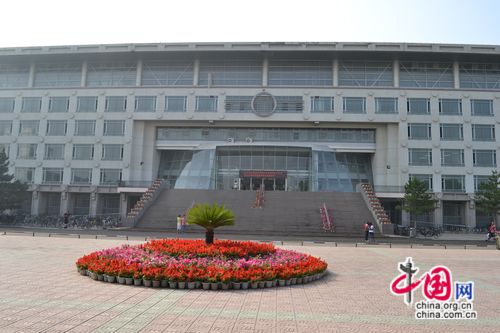Person-to-Person exchange at Inner Mongolia Agricultural University
- By Corey Cooper
 0 Comment(s)
0 Comment(s) Print
Print E-mail
China.org.cn, September 3, 2011
E-mail
China.org.cn, September 3, 2011
This week, I have been following the Inner Mongolia team of the China-US Youth RME Partnership, a new person-to-person exchange program sponsored by the All-China Youth Federation which sends Chinese and American students from top universities to interact with students in educational institutions throughout China.
On Tuesday, we got the chance to interact with students from Inner Mongolia Agricultural University in Hohhot, one of the autonomous region's most prestigious schools.
 |
|
Main teaching building at Inner Mongolia Agricultural University in Hohhot. |
At first glance, the campus was much more developed than I expected. Old, grown-in trees and ample amounts of green space created a scholarly atmosphere. The facilities also went way beyond my expectations, especially the library, student union, classrooms, and impressive athletic center. The university has been supported by local agricultural giants such as Mengniu Dairy, which operates a research facility on one of the school's campuses.
Outside the library, a sign bore words from Confucius and Genghis Khan, setting the stage for the multicultural learning environment. The cross-cultural connection between Han Chinese and the ethnic Mongolian student population was more evident when we toured the school's student media center, part of China's Student Media Union. As we entered, a student journalist was editing a publication in Mongolian dialect. We also checked out the school's bilingual student newspaper.
|
Don't miss: |
The depth of the school's student news website impressed me, as well as the strength of the school's news organization. Over 50 student reporters cover a wide range of on-campus events and also get the chance to cover societal and cultural happenings in Hohhot, including the city's annual cultural festival. They also blog about a wide range of academic topics.
One of our student guides, Wuyun Siqin, an ethnic Mongolian sophomore from the grassland areas outside Hohhot, explained that although ethnic Mongolian students in Inner Mongolia start learning Mandarin Chinese at an early age, typically five or six years old, they still get the chance to take some classes in Mongolian at Inner Mongolia Agricultural University. The school features separated and integrated classes, she explained. Wuyuan also delighted our group by singing a traditional Mongolian folk song when we arrived at the student media center.
Later that evening, we met with approximately 30 students for an impromptu exchange and networking session on the Agricultural University campus. This gave us a chance to reach out more in-depth to the students and answer some of their most pressing questions about life in the US as well as the American school system.







Go to Forum >>0 Comment(s)